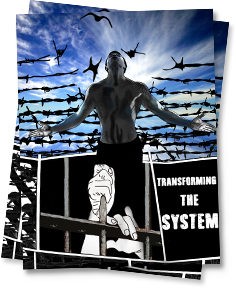Committing to Reducing Incarceration
Criminal justice policies should seek to substantially reduce incarceration because incarceration levels are at unacceptable levels. Criminal justice officials should be educated about the importance of carrying forth this goal, fostering an environment for transformation.
For its part, the Administration should:
- Draft an Executive Order, based on the executive authority to set prosecutorial priorities and to manage the federal prisons system, that states and federal law enforcement agencies should prioritize policies and practices that reduce the population of people who are imprisoned and prioritize community investment over imprisonment as a tactic for ensuring that the law is enforced;
- Require local and state grantees of federal funds relating to law enforcement activities provide information relating to specific demonstrable compliance with Title VI of the Civil Rights Act of 1964, 42 U.S.C. § 2000d, which prohibits discrimination based on race, color, or national origin in their applications to the federal government;
- Establish a National Taskforce on Justice or a National Commission on Justice “to review and evaluate all components of the criminal justice system for the purpose of making recommendations to the country on comprehensive criminal justice reform”;
- Establish an Interagency working group to develop a strategy for the elimination of racial and ethnic discrimination in the United States; and
- Take steps to ensure that pardons are used more extensively to address injustice in the criminal justice system, including taking steps to provide additional resources to the Pardons Office.
The Department of Justice (DOJ) should:
- De-prioritize the prosecution of less serious crimes and ensure that prosecutors have incentives to employ non-incarceration alternatives that do not result in criminal records by evaluating prosecutors on their use of non-incarceration alternatives;
- Ensure that the U.S. Department of Justice Civil Right Division’s (CRD) standard for initiating investigations into law enforcement agencies with a pattern and practice of discrimination reflects all legal and constitutional obligations and allows for investigations of all police departments that have reportedly violated the Violent Crime Control and Law Enforcement Act of 1994, 42 U.S.C. § 14141;
- Provide the CRD with additional capacity and resources to further meet the need to bring enforcement actions to hold criminal justice officials accountable; and
- Coordinate the work of the CRD with that of other divisions within the Department of Justice, including the U.S. Department of Justice Office of Community Oriented Policing Services (COPS), to ensure that police departments that are currently under investigations or that have outstanding cases for constitutional violations, are not awarded grants to hire additional police officers.
Congress should pass legislation that:
- Aims to reduce the prison population, consistent with the Reverse Mass Incarceration Act, which is a proposal for comprehensive reform that has not been introduced yet.
The local, state, and federal legislatures; and the local, state and federal executive branch should adopt legislation and/or policies that do the following:
- Require training on the effects of mass incarceration and the promotion of alternate responses to misconduct that do not include criminalization amongst educators, school administrators, criminal justice actors, mental health professionals, and social service providers;
- Review existing laws and consolidate redundant criminal laws that allow for prosecutorial abuse;
- Re-commit to international human rights and the domestic civil rights norms and principles by allowing for inspections by United Nations committees of U.S. prisons, complying with human rights standards for racial equity, and incorporating human rights into employee trainings, orientations, and handbooks for employees in institutions within the criminal justice system;
- Incorporate the voices of people who have been directly impacted by the criminal justice system including formerly incarcerated people, such as members of JustLeadership and the National Council for Incarcerated and Formerly Incarcerated Women, and survivors of police violence in the substantive decision making processes;
- Establish local and state taskforces on justice “to review and evaluate all components of the criminal justice system for the purpose of making recommendations . . . on comprehensive criminal justice reform” for that particular locality;
The U.S. Department of State in collaboration with the U.S. Department of Justice should develop an outreach strategy to ensure that all law enforcement agencies are complying with treaty obligations and human rights norms.
In addition to pressuring government officials to support the above actions, advocates, activists, cultural workers and artists, and civil society should:
- Continue to conduct widespread public education about the problems with mass incarceration, including the community harms, lack of fairness, inefficiencies, and systemic costs;
- Adopt a framework that allows for issues experienced by community members with intersectional identities, including women of color, black women, Muslim youth, Native American women and youth, LGBTQ people of color, transgender people of color, etc., to remain central to the conversation. This may include ensuring that speakers at rallies represent diverse backgrounds, promoting diversity amongst spokespeople who advocate for transformation, and continuously engaging in self-reflection to ensure that voices are not being silenced within the movement for transformation;
- “At protests, demonstrations, and other actions calling attention to state violence, include the faces, names, and stories of Black women alongside those of Black men;” as well as others who experienced state violence;
- Uplift the stories that highlight how the criminal justice system has impacted Native American people, whose stories have been absent in much of the mainstream media although they have incarceration and police killing rates comparable to that of African Americans;
- Incorporate the voices of people who have been directly impacted by the criminal justice system including formerly incarcerated people and survivors of police violence;
- Adopt communications strategies that have been proven to effectively educate the public about the harms of mass incarceration and implement the messaging tools in the toolkits that accompany this report to ensure that an effective and consistent criminal justice narrative is adopted; and
- Review the demands in this report as well as the shortened demands in the accompanying fact sheets and devise demands that are specifically tailored to address local realities.




